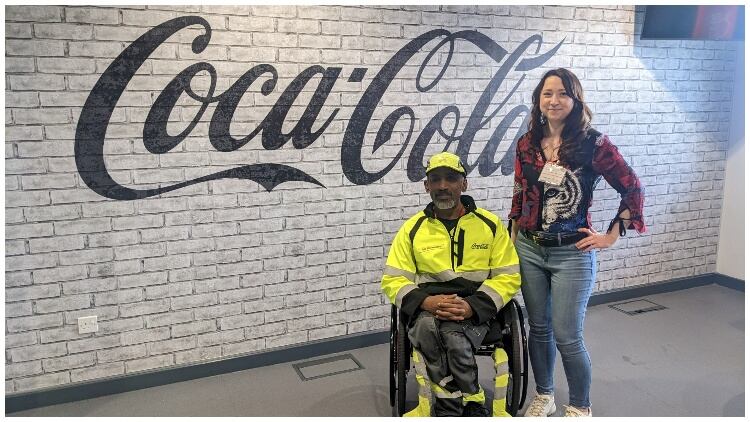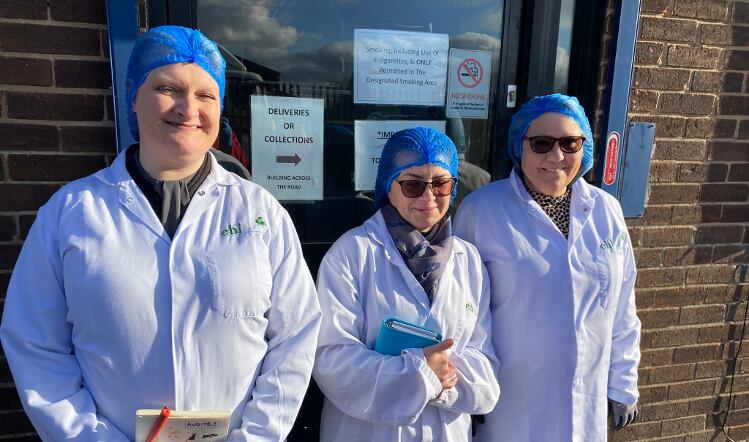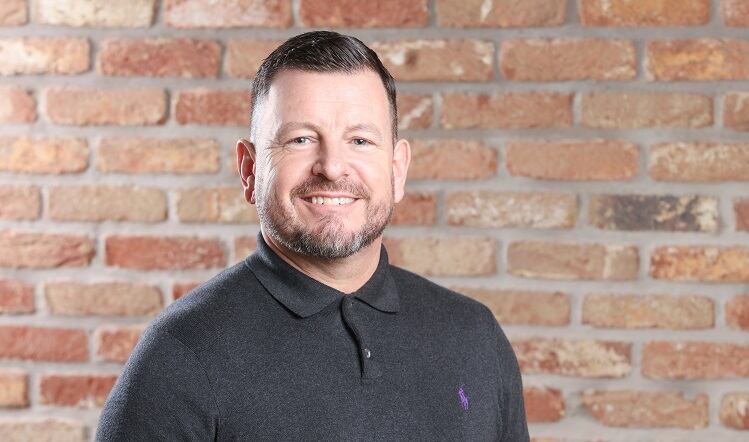Mohammad Koheeallee has been at Coca-Cola Europacific Partners (CCEP) for four years, starting his career as a grocery merchandiser within field sales and recently taking on a new opportunity as a health and safety coordinator within the Edmonton site in North London.
As a wheelchair user, Koheeallee has faced many challenges but most recently, how he can work safely within a manufacturing environment.
Reflecting on his career at CCEP, Koheeallee told Food Manufacture that the business had been incredibly supportive throughout. He shared examples of adjustments that were made in his initial position and how he also found his own way of doing things, such as developing strong rapports with staff members and training them to ensure inaccessible shelfs for him, which had been omitted from his duties, were still maintained and compliant.
Keen to broaden his experience, Koheeallee applied for an apprenticeship in health and safety at the Edmonton site. There were more barriers to overcome here, with raised curbs and fire doors to contend with, among other things. However, both Koheeallee and CCEP were determined to retrofit the site to enable a safe and inclusive environment.
“When I was offered this position, they said ‘we know Edmonton is not there, we need your help to get it to a point where it is accessible’. So I came in knowing that the site wasn’t accessible and there were restrictions, areas I couldn’t get to.”
Getting CCEP equipped for disabled workers
The first phase was getting the site audited by an external partner; from there a plan was formulated to create a more accessible factory. It was all about baby steps in the first instance, Koheeallee explained, with the initial focus on making sure he was safe on site and then widening the scope to address other issues.
There were times when Koheeallee’s colleagues also raised concerns about areas which were not necessarily a big hurdle. For example, forklifts and visibility – but as Koheeallee pointed out, all this needed was a cautious mindset and a risk assessment.
“I’m very safe; my attitude is very much: if there’s a vehicle, I will always let it pass.”
Another difficulty were pavement curbs and doors. The former was easily rectified by building in drop spots, where the curb is lowered far enough to enable a wheelchair user easier access. With regards to the latter, touchpoints were installed to automate opening, removing the effort of trying to open a heavy door whilst pushing a wheelchair through.
However, Koheeallee is mindful that there are some things which are beyond the company’s gift – at least for now.
“Food safety and health trumps equality law, so there are certain times I have to say to myself, I can’t go there.” The mixing area is one example.
“I can’t physically get my chair to the point where it’s really clean. So unless an incident occurs where I know the area will be sanitised and cleaned afterwards, I won’t go there. We’re not saying it’s impossible and it’s an area we’re looking into.”
One of the solutions that is being explored is a catch mat, but Koheeallee stated he is happy to wait whilst he addresses other areas. Saying this, Koheeallee did stress that if a wheelchair user came into the business wanting to work in an area such as mixing, he would make it a priority.
“I’d get them a dedicated chair for that area and we’d have a switch point in which they could swap wheelchairs.
“There are options, as long as a business is willing to look outside the box.”Speaking in terms of manufacturing as a whole, he added: “Unfortunately, that doesn’t happen enough.”
Start thinking differently
He flagged that oversights are often made in these facilities, particularly during the build of the structure itself, such as no consideration for door width.
When he was first contemplating the food and drink sector as a career, Koheeallee said he had doubts it would be a viable career path, a view which had been reenforced by the lack of representation in TV programmes.
“Never once did I see any TV programmes – ‘how they do it shows’ – that showed someone in a wheelchair working in these sites.
“When you look at the way these sites are built, you can understand why. You see stairs everywhere. You think to yourself, is that really the best way you could have built it?”
It may come as a surprise, but 80% of people with a disability acquire them later in life.1
Commenting on this, he stated that “no manufacturer is ready for someone to have a life changing injury”.
Wanting to make a difference, Koheeallee requested to become the company’s accessibility ambassador for GB – of which he has recently been appointed. Within this role, he now undertakes the warehouse audits and is doing so across four CCEP sites. This enables him to provide each factory with feedback and ensure it is doing its utmost to be inclusive.
But he’s not alone in this mission, he has a team of 48 ambassadors that help him address and implement change within the business.
The strong leadership within CCEP has also helped Koheeallee gain what he described as “the voice of courage”.
He added: “Without their [line managers] support, I wouldn’t be here. I could be screaming from the high heavens, but if you haven’t got a leader who is willing to listen, where will you get to…?”
Koheeallee hopes that his ambassador role will also provide colleagues who need more support, the same courage to speak up and ask for help.
His ambassadorship also means he’s responsible for assessing projects before they go live at CCEP to ensure they are inclusive. Further to this, Koheeallee is having conversations with a range of external businesses around line construction to address the issues of building with inclusivity in mind.
“When you look at how something is built, just think carefully about how you build it,” he urged. “Having a control panel three quarters up the wall doesn’t benefit anyone, but lowering it would help others. Think about screens with movable platforms to help someone who may have a movement problem, something that enables them to sit down and still use it.
“I don’t see enough manufacturers thinking about this. They just go in there and build a line. As long as they build it, they’re happy. But there’s more to it.
“Unfortunately, you will have managers who see what’s required to run a line so that when they go out and hire, subconsciously or consciously, they look specifically for people to meet those criteria.” In other words, if it’s made inaccessible it’ll narrow the talent pool.
In fact, the rate of unemployment among disabled people is twice as likely as non-disabled people, with the disability employment gap set at 29%.2
With the industry experiencing issues with recruitment, it’s absurd to be cutting off opportunities to a portion of the population simply because the sector is not accessible.
Support for those with accessibility issues
Offering advice to others in similar circumstances to Koheeallee, he said: “Don’t be afraid to look for help from external partners. For example, the people at the job centre – make sure you reach out and ask for advice and what support they can provide.”
He continued: “Access to Work is a great tool – it’s a programme which supports people with long term illness, disabilities and mental health to stay in the workplace. In my situation, I was doing on average 10,000 pushes a day – it was exhausting. I knew what I needed, which was a set of electric wheels – so for every push I do, I get two back.”
These are very expensive however, so Koheeallee applied for funding through Access to Work. He still had to contribute a portion of the money but as he said, “the benefits outweighed the cost”.
He added: “Without this I would definitely be gone.”
Creating an inclusive environment
Equipped and determined, Koheeallee told Food Manufacture his current objective for CCEP is to create an overall inclusive environment.
“I’m focusing on the conditions that affect the majority right now – physical disabilities, dyslexia, ADHD,” he said. “So that if someone with a more severe disability comes in, they won’t want to leave, instead they’ll ask: ‘how can you support me to stay here?’ It’s about creating that environment, having it steady and in place.”
With six million households including one disabled member and 1.6 million with two or more in the UK alone, how equipped are you for accommodating such an environment as Koheeallee is championing? It’s time we took a good, hard look at our factories and protocols.
References
- Facts and figures about disabled people in the UK. Available at: https://www.disabilitysport.org.uk/facts-and-figures-about-disabled-people-in-the-uk.html (Accessed: 19 May 2023).
- Disability facts and figures: Disability charity scope UK (no date) Scope. Available at: http://www.scope.org.uk/media/disability-facts-figures/ (Accessed: 19 May 2023).
- Waddington, B. (2023) Disability, England and Wales: Census 2021, Disability, England and Wales - Office for National Statistics. Available at: https://www.ons.gov.uk/peoplepopulationandcommunity/healthandsocialcare/healthandwellbeing/bulletins/disabilityenglandandwales/census2021 (Accessed: 19 May 2023).





